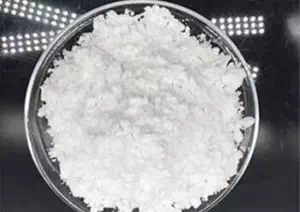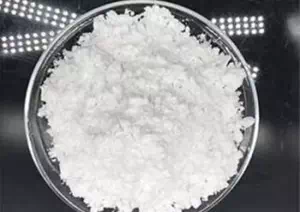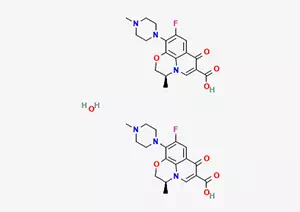All Categories



levofloxacin heMihydrate CAS 138199-71-0, levofloxacin heMihydrate, CAS 138199-71-0
Levofloxacin lactate, as a member of the quinolone class of drugs, is renowned for its broad-spectrum antibacterial properties.
CAS : 138199-71-0
Formula : C18H22FN3O5
Mol. wt. : 379.39
EINECS : 604-067-2
Chemical Name | Levofloxacin heMihydrate |
Other Name | Ofloxacin |
CAS | 138199-71-0 |
EINECS | 604-067-2 |
Type | Additives; Pharmaceutical raw materials; Pharmaceutical, pesticide and dye intermediates |
Molecular Formula | C18H22FN3O5 |
Molecular Weight | 379.39 |

Melting point | 214-216°C |
storage temp. | Sealed in dry,2-8°C |
solubility | Aqueous Base (Slightly), DMSO (Sparingly), Methanol (Slightly) |
color | Pale Yellow to Light Yellow |
Levofloxacin lactate, as a member of the quinolone class of drugs, is renowned for its broad-spectrum antibacterial properties. This medicine has demonstrated a powerful antibacterial effect and can effectively combat a variety of bacteria. Among Enterobacteriaceae bacteria, it has demonstrated significant antibacterial activity, including but not limited to Escherichia coli, Klebsiella, Proteus, Salmonella and Shigella, etc. In addition, levofloxacin lactate also has a strong antibacterial effect on Gram-negative bacteria such as Haemophilus influenzae, Legionella pneumophila and Neisseria gonorrhoeae.
Not only that, this drug also has a good antibacterial effect on some Gram-positive bacteria such as Staphylococcus aureus, Streptococcus pneumoniae and Streptococcus pyogenes, etc. Meanwhile, it can also exert inhibitory effects on atypical pathogens such as Mycoplasma pneumoniae and Chlamydia pneumoniae. However, it is worth noting that levofloxacin lactate has a relatively weak antibacterial effect on anaerobic bacteria and enterococcus, which is a limitation in its antibacterial spectrum.

This product, as the levorotatory (L-form) of ofloxacin, shows significant advantages in antibacterial activity, and its antibacterial activity is approximately twice that of ofloxacin. This unique property gives it a special position in the field of antibacterial.
Its main mechanism of action lies in precisely inhibiting the activity of bacterial DNA rotase (that is, bacterial topoisomerase I), and ingeniously hindering the replication process of bacterial DNA in this way. This mechanism of action is like setting up a solid barrier at the core link of bacterial growth and reproduction, thereby effectively inhibiting the growth and reproduction of bacteria.
This product features a broad antibacterial spectrum and strong antibacterial effect. It can exert a powerful antibacterial ability when facing numerous bacteria. Specifically, for the majority of Enterobacteriaceae bacteria, it has demonstrated outstanding antibacterial effects. For example, Escherichia coli, a type of bacteria that is common in the human intestinal tract and may cause various infections, this product can effectively inhibit it. Klebsiella, as a conditional pathogen, is relatively common in cases such as hospital infections and is also within the antibacterial range of this product. Serratia, Proteus and Shigella, etc. are also unable to escape the antibacterial efficacy of this product.
Not only that, this product has strong antibacterial activity against Gram-negative bacteria such as Salmonella, citrobacter, Acinetobacter, Pseudomonas aeruginosa, Haemophilus influenzae, and Neisseria gonorrhoeae. Among them, Salmonella can cause intestinal infections and other diseases, Citrobacter may also lead to human infections in some cases, and Pseudomonas aeruginosa is a common pathogen of nosocomial infections with a tendency of multi-drug resistance. However, this product can still exert effective antibacterial effects on it.
In addition to its strong antibacterial ability against Gram-negative bacteria, this product also has a good antibacterial effect on some Gram-positive bacteria. For example, for methicillin-sensitive Staphylococcus aureus, which is a bacterium commonly causing infections in the skin, soft tissues and other parts, this product can inhibit its growth. Streptococcus pneumoniae, as one of the important pathogens causing respiratory tract infections, is also within the antibacterial spectrum of this product. Streptococcus pyogenes and Streptococcus hemolyticus, etc. will also be inhibited by this product. In addition, this product can also exert a good antibacterial effect on atypical pathogens such as Legionella, mycoplasma and chlamydia.
However, it should be noted that the inhibitory effect of this product on anaerobic bacteria and enterococcus is relatively poor. In clinical applications, it is necessary to rationally select and use this product based on the specific type of infection and the condition of pathogenic bacteria to ensure the best antibacterial therapeutic effect.
* Prompt reply and 24 hours online, professional team to provide best price and high quality product.
* Sample testing support.
* Every batch of products will be tested to ensureits quality.
*The packing also can be according the customers` requirment.
*Any inquiries will be replied within 24 hours.
*we provide Commerical Invoice, Packing List, Bill of loading, COA , Health certificate and Origin certificate. If your markets have any special requirements, let us know.